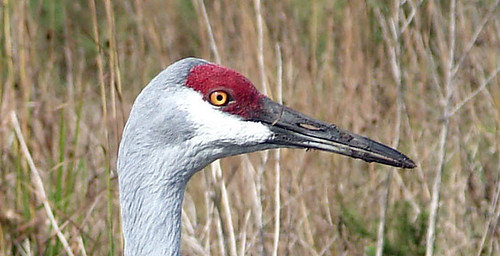The only thing more splendid than looking at a Sandhill Crane is listening to one. Don Kroodsma shares some wonderful recordings of Sandhill Cranes on his birdsongforthecurious.com website, including one that lasts 23 minutes. Cranes are not considered songbirds, but Don understands that birdsong transcends taxonomy.
You know, there are many reactions to Sandhill Cranes. Sadly, one of them by hunters is “ribeye in the sky.” And my heart dies when I hear that, that there’s an open season on these magnificent creatures. Stately.
You’ve probably got favorite Sandhill Crane experiences yourself. So I was in the northern part of Lower Michigan, a mile south of the bridge a couple years ago, April, the lakes were still frozen over, and in came this pair of Sandhill Cranes to set up a territory. And there’s something remarkable about listening to a male and a female duetting. Here we have again—the female is taking a significant role in all of the—well, go ahead and call it singing. What else would we call it?
And here they were, about 70 yards away. I would sneak out to the dock and just listen and watch them. I’ve got a couple of stereo recordings where I would encourage listeners to just close your eyes. You hear the male’s lower trumpet or bugle or whatever you want to call it, and she follows immediately after or overlapping, sounding as if they were one bird on many occasions, and that’s no doubt their intent, sounding as if they are a pair defending this territory.
So this particular selection that I’m pointing your towards, Laura, it’s amazing to listen to them. First of all, they’re right out in front of us, and then they start to fly around the lake, and you can hear the male and the female off to the left and off to the right, and then, after they’ve made this circle over the lake, they disappear in the distance to the right. Just a wonderful sequence of male and female advertising that they own this little lake and there better not be any intruders.
Territorial birds take umbrage at intruders. Don uses this interaction between the paired cranes and the intruder to make an important point for birders and photographers.
There’s a lot of talk about the ethics of doing playbacks by birders. We take a song, we play it back to the bird, we bring it in, and some of us would say yes, we’re harassing that bird, and please don’t do playbacks to harass the birds.
Well, sometimes there are what we might call a natural playback. Here you have the male and female Sandhill Crane on their territory. They’re munching happily along, foraging in the woods, and a female starts to call. You can hear her in this recording (#43). She’s way off to the left and you hear her coming closer. She has a unique call that she gives, and closer and closer, and finally she’s right there in the center of this little lake, and the male and female residents, well, they ain’t too happy with all of this, and they come out of the woods, stand on the edge of the lake, and it’s the female—the resident female who first attacks this intruding female. She chases it off to the right and the male’s left calling all alone, then the male flies off and meets her coming back after she successfully chased this intruder away, and then I let the recorder run and for about 20 minutes you can hear the excitement and the energy that these two birds put into their bugling and it’s what I would call a natural example of a playback of an intrusion, but it suggests also reasons why we should be doing far fewer playbacks to birds.
Click here to listen to Don’s splendid crane recordings. These recordings are so much richer when you can read Don’s explanations. His book, Birdsong for the Curious Naturalist, is one of the very few books I think everyone should have.
